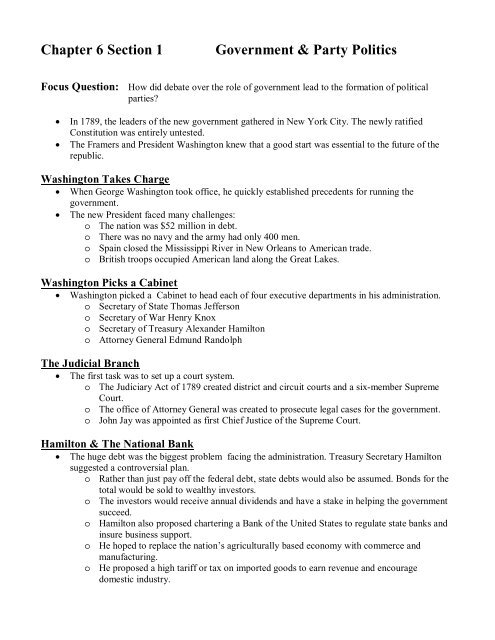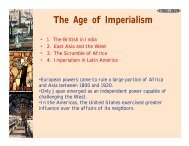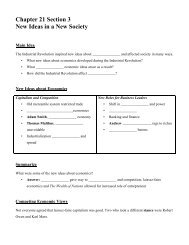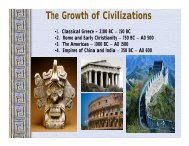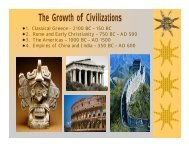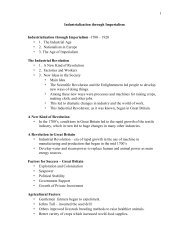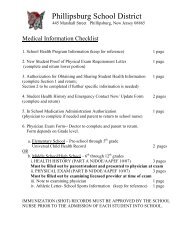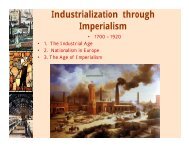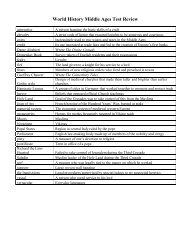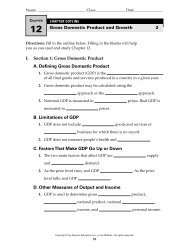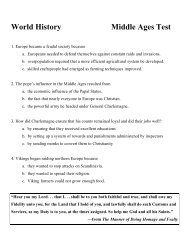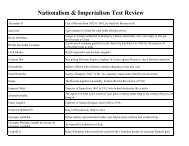Chapter 6 Section 1 Notes
Chapter 6 Section 1 Notes
Chapter 6 Section 1 Notes
You also want an ePaper? Increase the reach of your titles
YUMPU automatically turns print PDFs into web optimized ePapers that Google loves.
<strong>Chapter</strong> 6 <strong>Section</strong> 1<br />
Government & Party Politics<br />
Focus Question: How did debate over the role of government lead to the formation of political<br />
parties?<br />
<br />
<br />
In 1789, the leaders of the new government gathered in New York City. The newly ratified<br />
Constitution was entirely untested.<br />
The Framers and President Washington knew that a good start was essential to the future of the<br />
republic.<br />
Washington Takes Charge<br />
When George Washington took office, he quickly established precedents for running the<br />
government.<br />
The new President faced many challenges:<br />
o The nation was $52 million in debt.<br />
o There was no navy and the army had only 400 men.<br />
o Spain closed the Mississippi River in New Orleans to American trade.<br />
o British troops occupied American land along the Great Lakes.<br />
Washington Picks a Cabinet<br />
Washington picked a Cabinet to head each of four executive departments in his administration.<br />
o Secretary of State Thomas Jefferson<br />
o Secretary of War Henry Knox<br />
o Secretary of Treasury Alexander Hamilton<br />
o Attorney General Edmund Randolph<br />
The Judicial Branch<br />
The first task was to set up a court system.<br />
o The Judiciary Act of 1789 created district and circuit courts and a six-member Supreme<br />
Court.<br />
o The office of Attorney General was created to prosecute legal cases for the government.<br />
o John Jay was appointed as first Chief Justice of the Supreme Court.<br />
Hamilton & The National Bank<br />
The huge debt was the biggest problem facing the administration. Treasury Secretary Hamilton<br />
suggested a controversial plan.<br />
o Rather than just pay off the federal debt, state debts would also be assumed. Bonds for the<br />
total would be sold to wealthy investors.<br />
o The investors would receive annual dividends and have a stake in helping the government<br />
succeed.<br />
o Hamilton also proposed chartering a Bank of the United States to regulate state banks and<br />
insure business support.<br />
o He hoped to replace the nation’s agriculturally based economy with commerce and<br />
manufacturing.<br />
o He proposed a high tariff or tax on imported goods to earn revenue and encourage<br />
domestic industry.
Arguments For The National Bank<br />
Hamilton saw 3 advantages to his financial plan<br />
o The plan would establish the nation’s financial credibility.<br />
o The plan would gain political support from the wealthiest Americans.<br />
o The plan would enrich investors who would reinvest and thus create more wealth.<br />
Arguments Against The National Bank<br />
Antifederalists objected to Hamilton’s plan. They had 3 main complaints:<br />
o Wealth would be redistributed from farmers to merchants, and from the South to the North.<br />
o Investors who purchased the bonds would make huge profits at everyone else’s expense.<br />
o The costs would fall on farmers who would have to pay excise taxes and higher tariffs.<br />
Jefferson & The National Bank<br />
Secretary of State Jefferson opposed Hamilton’s plan.<br />
o Most southern states had already paid off their war debts. He asked why they should bail<br />
out northern states that still had debts.<br />
o Jefferson believed the plan gave more power to the government than the Constitution<br />
permits.<br />
Strict vs Loose Construction<br />
Jefferson favored a strict construction of the Constitution.<br />
o Congress should be limited to the powers specifically granted by the Constitution.<br />
o The Constitution does not give Congress power to charter a national bank, so it could not<br />
establish one<br />
Hamilton favored a loose construction of the Constitution.<br />
o Congress has implied powers, and can take any actions not specifically forbidden.<br />
o The Constitution allows Congress to act for the “general welfare” so it could charter a<br />
bank.<br />
A National Bank & A New Capital<br />
In 1791, Congress accepted Hamilton’s plan.<br />
o The national debt was funded, outstanding state debts were assumed, excise taxes and<br />
tariffs were levied, and the bank was authorized.<br />
o In return, a new national capital was created. Washington D.C. would be placed in the<br />
South, on the banks of the Potomac River.<br />
Whiskey Tax Causes Problems<br />
An excise tax on whiskey led to divisions between the Federalists and the Antifederalists.<br />
o To increase their profits, western Pennsylvania farmers made whiskey from their grain.<br />
o The whiskey tax reminded farmers of British taxes.<br />
o In 1794, some farmers resisted payment. They harassed and intimidated tax collectors.<br />
The Whiskey Rebellion<br />
Hamilton persuaded Washington to suppress the Whiskey Rebellion.<br />
o Twelve thousand militiamen were sent to deal with the rebellion, but they found no<br />
organized insurrection.<br />
o Then Jefferson criticized Hamilton for the use of federal force to repress legitimate<br />
criticism.
Political Parties Emerge<br />
Despite Washington’s disapproval, two political parties emerged.<br />
o Democratic Republicans<br />
Favored Jefferson and Madison.<br />
This party was strongest among Southerners and farmers.<br />
o Federalists<br />
Favored Hamilton and was strongest among Northerners, merchants, and the<br />
wealthy.


